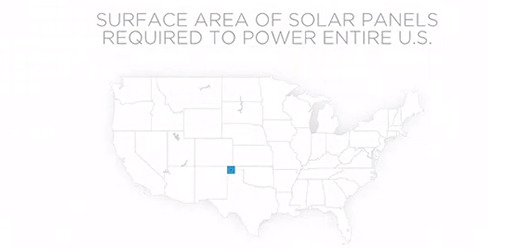The power of the sun is really amazing and somehow underestimated. Here is the solar panels surface required to power the entire US (100%):

The product is manufactured by Tesla and is a full energy storage system for a sustainable home, as the producer describes it. The solution is called Powerwall, and the concept is simple: The battery charges through solar panels (or through the electrical grid, if you prefer) and acts as an emergency backup electricity supply whenever the power is out. You can use several solar panels and several Powerwall home batteries so that you can go completely off the grid!
Powerwall is easy to mount and simple to use. And the best thing about it is that it can power your entire house as well as the most important appliances that you want to keep powered 24/7. Thus, Powerwall can keep your refrigerator or your freezer working properly during longer outages.
Will it “survive” an EMP? If you don’t have extremely long wires… I think yes! (Read more: EMP Myths and Facts)
Electricity is stored within the Powerwall battery. Then a power inverter converts electricity into alternating current, which fuels your appliances. The alternating current goes through your home’s electrical panel; installing a backup electrical panel can help you use Powerwall to fuel just the selected appliances, and it also protects it from the effects of an EMP.
According to the manufacturer, “Powerwall comes in 10kWh weekly cycle and 7kWk daily cycle models. Both are guaranteed for ten years and are sufficient to power most homes during peak evening hours. Multiple batteries may be installed together for homes with great energy need, up to 90kWh total for the 10 kWh battery and 63 kWh total for the 7kWh battery.”
Here is a short clip from the initial release:
The technical description of the product, offered by Tesla, is as follows:
- Technology – Wall-mounted, rechargeable lithium ion battery with liquid thermal control
- Models – 10 kWh, $3,500 for backup applications; 7 kWh, $3,000 for daily cycle applications
- Warranty – 10 years
- Efficiency – 92% round-trip DC efficiency
- Power – 2.0 kW continuous, 3.3 kW peak
- Voltage – 350–450 volts
- Current – 5.8 amp nominal, 8.6 amp peak output
- Compatibility – Single phase and three phase utility grid compatible
- Operating Temperature – -4°F to 110°F (-20°C to 43°C)
- Enclosure – Rated for indoor and outdoor installation
- Installation – Requires installation by a trained electrician; DC-AC inverter not included
- Weight – 220 lbs. (100 kg)
- Dimensions – 51.2″ x 33.9″ x 7.1″ (1300 mm x 860 mm x 180 mm)
- Certification – NRTL listed to UL standards
It’s not very likely to be able to power a standard house with all the appliances we are used to running on a daily basis using just one Powerwall. However, people agree that they waste a lot of energy as long as it is supplied by the national grid. Once their energy source is limited and they start paying more attention to their lifestyle, most people notice that they can maintain a comfortable way of life with much less electricity. A Powerwall combined with solar panels can pretty much preserve your way of life during a massive outage, like the one that would follow an EMP, as long as Powerwall and the solar panels are mounted completely separate from the national electrical grid.
You can access their website here.
How to Build an EMP Emergency Car Bag
This Bug Will Kill Most of the Americans during the Next Crisis (Video)
















am interested
How would a PowerWall and Li bats with PV modulesbe EMP proof? All systems use high tech electronics. The panel/bat voltage is incompatible with a home power system. PV modules have diodes sealed in. Li cells each have a micro processor to keep cells balanced (temp/voltage) as well as the BOS. Voltage of system is electronically lowered for bat charging.
If you want a resilient system; you need to use older tech pv modules with accessable J boxes and store replacement diodes in a faraday cage and use lead acid, nife, nmhd; or salt water deep cycle bats. Forget the lightweight/efficiency crap by the Li people. We are looking at total cost of system and resiliency. Weight or size of a bat bank matters little in a home power system. It is possible to actually build a non electronics (Yes, without diodes) pv/bat system. I’ve had lead acid bats last up to 30 years in such a system (without electronic charge control). I have 36 yr old pv modules operating at about 10% less eff than original.
Hi Gardener, I like your comments on this system, and i wonder could you help me with info on what you did and what you used for your system which has lasted so long, as i am still trying find my way through a minefield of stuff on solar pv and how best to do it for of grid use, best regards.
Check out the Aquion Carbon Salt Water deep cycle system which is 52 wide X 40 deep” 45 high” high and has no acid or toxic substances at all it is a self contained unit and will fit into a home made faraday cage which is very easy to build yourself. It sits in the corner of my garage and just works has a better cycle life then lithium or acid core batteries and 100% non toxic. Works great with Solar, Wind or Hydro generators i have all 3 so if I lose one I still have 2 other sources. All you need to hook it up is wires to you panel and wires to your sources.It has its own built in Charge regulator and invertors to output 115 ACV and charges with 48VDC feeds.
You mean shit that you can’t actually buy…. Why it just suggest looking into clean nuclear energy?…. Cause youcant buy it! (Yet)
will these , up for order now ?
FYI to all concerned. The price of the powerwall listed in the article is WAY off. It is somthing like $7700 bucks installed. Plus, when I contacted tesla they “recommended” certain (thiers of course) solar panels. But they said it could be used with most 24 volt solar panels.
Honestly I thihnk there are cheaper wasy to do a battery back up for the home.
But for someone who has money laying around and jsut wants to “get it done turnkey” this might suit.
JKS:
They gave me a quote for $29k for my 1700 sf 2 story house with a cost per month of $100. now for electricity. Plus, they said they don’t do my area right now…..so I guess I can’t get this.
PLUS: they won’t give you an estimate, unless you “order now”. I HATE those types of sales! They ask for ALL of your information UP FRONT…Thanks, but no thanks. I’ll figure something else out
will a portable power inverter survive an EMP?
The whole page now outdated. One model only is reportedly sold. Plus you must purchace it installed by his
Installers. Might be good product but there’s several 12,24 & 48 lithium batteries now available .self installed or contractor of your choice not tesla .empneeds some type of faradaycage protecting all electronics .and most larger lithium battery has bms electronic circuitry.
Interesting: The title says “…Power your Home COMPLETELY.”””
Yet the post says “…It’s not very likely to be able to power a standard house with all the appliances we are used to running on a daily basis….”
So, my question is: WHY then, is this any better than other solar power systems we have available now???